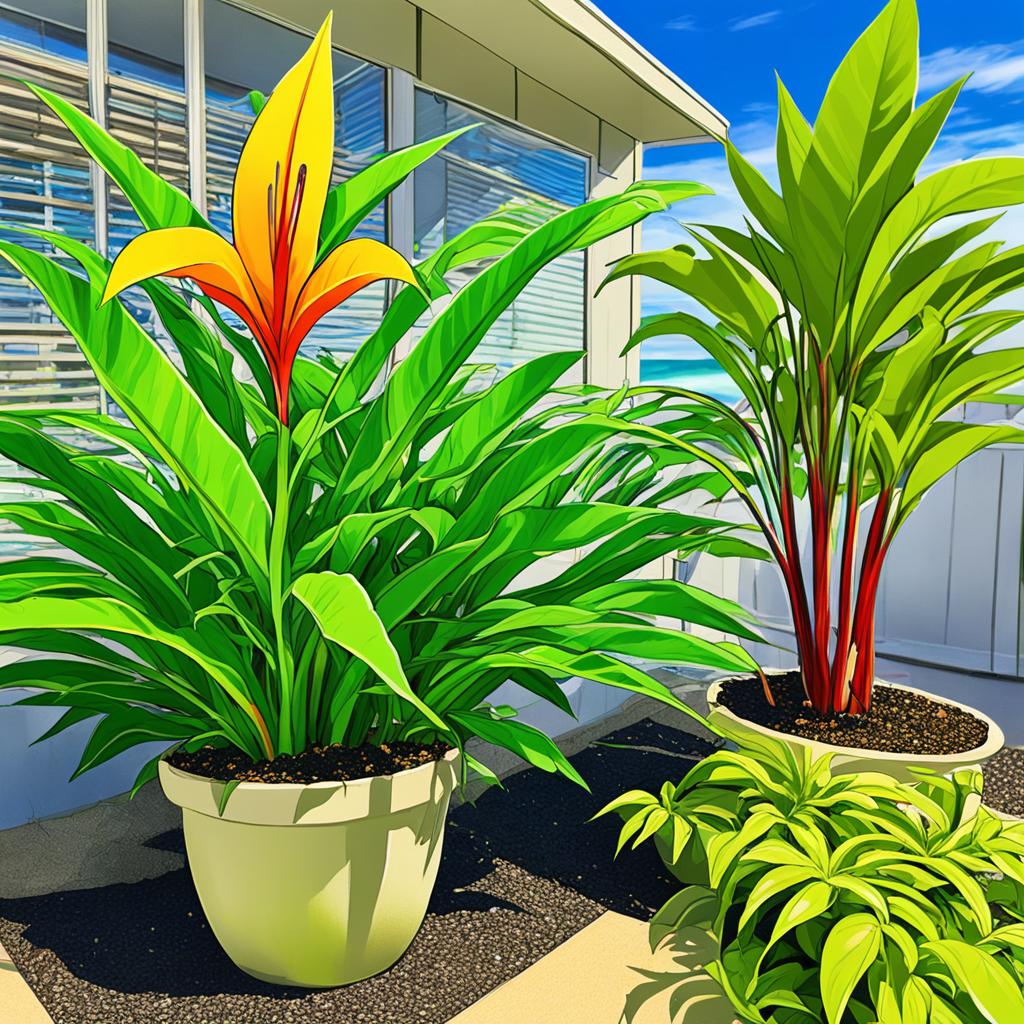Are you curious to know how quickly Hawaiian Ti plants can transform your garden or indoor space? Hawaiian Ti plants, scientifically known as Cordyline fruticosa, are renowned for their vibrant red and purple leaves. But did you know that these tropical plants also have rapid development capabilities?
Many people wonder about the growth rate of Hawaiian Ti plants. How long does it take for them to reach a considerable size? Can their growth be accelerated? In this article, we will explore the fascinating growth journey of Hawaiian Ti plants and provide insights on their optimal growing conditions, uses, care tips, propagation, and pruning techniques.
Whether you’re a seasoned gardener or a newbie, understanding the growth rate of these magnificent plants and how to best nurture them will empower you to create a flourishing tropical paradise in your own backyard or indoor oasis.
So, let’s delve into the world of Hawaiian Ti plants and uncover the secrets to their rapid development. Buckle up for an informative and inspiring journey!
Ideal Growing Conditions for Hawaiian Ti Plants
Ti plants, also known as Cordyline fruticosa, can be cultivated both indoors and outdoors, adapting well to various environments. Whether you choose to showcase their vibrant beauty inside your home or create a tropical paradise in your outdoor space, providing optimal conditions is key to their thriving growth.
Growing Ti Plants Indoors
When cultivating Ti plants indoors, it’s important to consider their light requirements. While they can tolerate low light conditions, prolonged exposure to low light may result in stretched and pale new growth. To maintain their vibrant colors and healthy development, place your Ti plant containers in well-lit areas near windows where they can receive bright, indirect light.
Growing Ti Plants Outdoors
In outdoor settings, Ti plants flourish when provided with at least 4 hours of direct sunlight or bright, indirect light. Ideally, find a spot in your garden that receives ample sunlight to ensure their optimal growth. Alternatively, Ti plants can be grown underneath tall trees that offer shade, which mimics their natural habitat.
Soil and Watering
Ti plants thrive in well-drained, loamy soil. Ensure the soil is moist but not waterlogged, and water the plants when the top inch or two of the soil feels dry. This allows the roots to receive adequate moisture without risk of rotting. Ti plants appreciate regular watering, especially during hot and dry periods, to maintain their health and vitality.
Fertilization
To promote healthy growth, fertilize your Ti plants once a month during the spring and summer seasons. You can use either a liquid or slow-release fertilizer, diluted to half the recommended strength, to provide essential nutrients without overwhelming the plants. However, be cautious as Ti plants are sensitive to fluoride, so ensure your fertilizers or water sources are free from fluoride content.
With these optimal conditions met, your Hawaiian Ti plants will thrive, adding a touch of tropical elegance to your indoor or outdoor space.
Uses of Ti Plants

Ti plants, also known as Hawaiian Ti plants or Cordyline fruticosa, are versatile and attractive plants that can be used in various ways to enhance your landscape or indoor space. With their vibrant and colorful foliage, they bring a touch of tropical beauty wherever they are placed.
Here are some common uses of Ti plants:
- Accent Plants: Ti plants are excellent choices as accent plants, adding a pop of color and visual interest to your garden or landscape. Their bold foliage stands out and creates a focal point, drawing attention to specific areas or features.
- Hedges and Screens: Due to their upright and bushy growth habit, Ti plants can be planted close together to form beautiful hedges or screens. They provide privacy and serve as a natural barrier while adding a tropical flair to your outdoor space.
- Mass Plantings: Ti plants can be planted en masse to create stunning displays of color. Whether you choose a monochromatic scheme or mix different varieties, the result is a vibrant and eye-catching landscape.
- Foundation or Background Plantings: With their height and lush foliage, Ti plants make great choices for planting alongside foundations, fences, or walls. They add depth, texture, and a tropical backdrop to the surrounding landscape.
- Container Plants: Ti plants are well-suited for container gardening. Whether on your deck, patio, or lanai, they add a touch of the tropics to your outdoor living space. Placed in decorative pots or planters, they create a striking focal point and can be easily moved to different locations.
The Versatility and Popularity of Ti Plants
One of the reasons Ti plants are widely used is their adaptability. They can tolerate a wide range of growing conditions and are relatively low-maintenance. Whether you have a small urban balcony or a spacious garden, Ti plants can be incorporated into your landscape design seamlessly.
Furthermore, Ti plants are easily propagated, making them popular choices for both experienced gardeners and beginners. They can be propagated from stem cuttings or by planting seeds, allowing you to expand your Ti plant collection or share them with friends and family.
With their distinctive beauty and versatility, Ti plants have become coveted additions to many gardens, landscapes, and indoor spaces. Whether used as accent plants, hedging, mass plantings, foundation plants, or container plants, they bring a touch of tropical paradise wherever they are planted.
| Uses | Description |
|---|---|
| Accent Plants | Stand out with their vibrant foliage and create visual interest in the landscape. |
| Hedges and Screens | Plant them close together to form natural barriers and add privacy to outdoor spaces. |
| Mass Plantings | Create stunning displays of color by planting Ti plants en masse. |
| Foundation or Background Plantings | Add depth and a tropical backdrop when planted alongside foundations or fences. |
| Container Plants | Bring the tropical vibe to your outdoor living spaces by planting Ti plants in containers. |
Care Tips for Hawaiian Ti Plants

Proper care is essential for the health and growth of Ti plants. By providing the right watering, fertilizer, sunlight, and humidity, you can ensure that your Ti plants thrive and flourish.
Watering: Ti plants should be watered when the top inch or two of the soil is dry. It’s important to allow the soil to dry out slightly between waterings to prevent root rot. Overwatering can be detrimental to the plant’s health. Remember, it’s better to underwater than overwater Ti plants.
Fertilizer: Ti plants can benefit from monthly fertilization during the spring and summer months. Choose a liquid or slow-release fertilizer and dilute it to half the recommended strength. This will provide the necessary nutrients without overwhelming the plant.
Sunlight: Ti plants prefer bright, indirect light. Place them in well-lit areas near windows where they can receive the appropriate amount of light. When grown outdoors, Ti plants require at least 4 hours of direct sunlight or bright, indirect light to thrive.
Humidity: Ti plants thrive in humid environments. If you’re growing them indoors, it may be necessary to increase the humidity levels, especially during dry winter months. You can do this by using a humidifier, placing the plants on a tray with water and pebbles, or misting the leaves regularly.
Sensitivity to Fluoride: Ti plants are sensitive to fluoride, so it’s important to avoid using fertilizers or water that contains fluoride. This can cause leaf discoloration and harm the plant’s overall health.
Temperature: Ti plants cannot tolerate temperatures below 50 degrees Fahrenheit. During the winter months, make sure to protect them from drafts and keep them in a warm environment.
By following these care tips, you can ensure that your Hawaiian Ti plants stay healthy, vibrant, and beautiful.
Propagation and Pruning of Ti Plants
Ti plants, also known as Cordyline fruticosa, can be propagated through various methods, offering gardeners and plant enthusiasts several options to expand their collection. One of the simplest methods is rooting short stem cuttings in arid soil. To do this, take a healthy stem cutting, remove the lower leaves, and plant it in well-draining soil. Keep the soil slightly moist and provide indirect light to encourage the development of roots. Another propagation method involves placing stem cuttings in water until roots emerge, then transplanting them into pots.
When it comes to pruning Ti plants, regular maintenance is crucial for their health and appearance. Remove yellowed leaves as they appear to prevent the spread of diseases and pests. To encourage new growth and a bushier shape, trim back lanky or unattractive stalks. Pruning can also help control the height of Ti plants indoors or promote overall compact growth. Remember to use clean, sharp tools to make clean cuts and reduce the risk of damage or infection.
By understanding the different propagation methods and adopting proper pruning techniques, you can successfully propagate and maintain the health and aesthetic appeal of your Ti plants. Whether you’re expanding your collection or tending to an existing Ti plant, propagation and pruning are essential practices for Ti plant enthusiasts.


